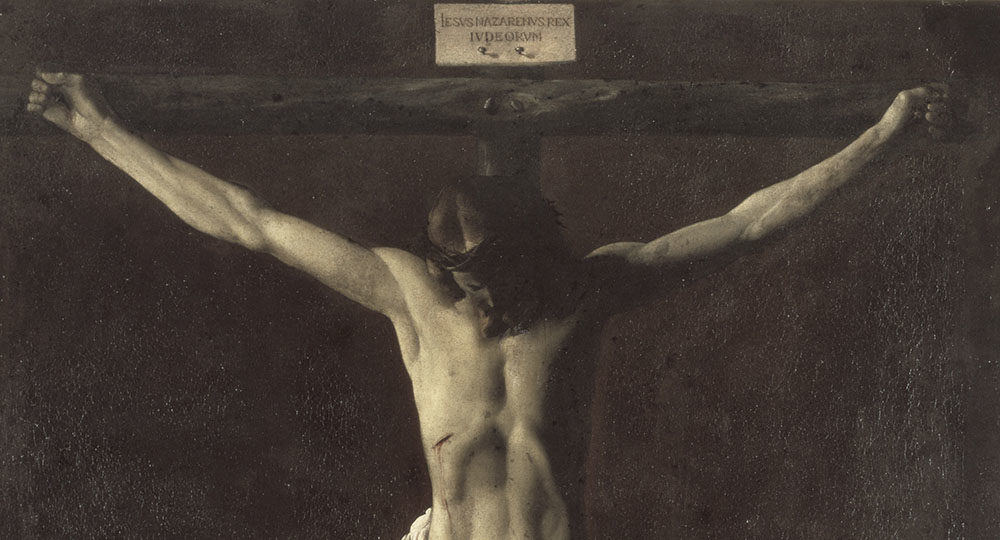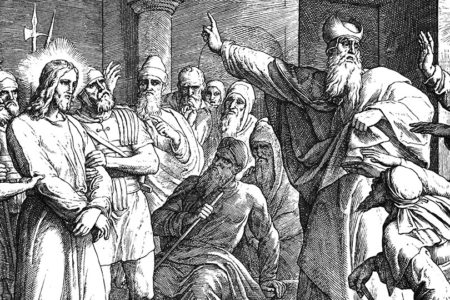The Mocking of the Messiah
The Roman general Pompey laid siege to Jerusalem in 63 B.C. Having made Syria a Roman province the preceding year it was now Judea’s turn to be conquered. Twelve thousand Jews died in the ensuing melee. Few Romans perished. When the struggle ended, Pompey marched into the most sacred room of the Temple, the Holy of Holies. Then, to his credit, he withdrew from the Temple, leaving its treasures intact. Jerusalem itself, however, was profoundly changed. The holy city became a tributary to the Romans. Judean independence, shortly lived under the Maccabees, was lost. For hundreds of years to follow, the Jewish people living in the environs of Judea were subjects of Rome. The great iron-toothed monster of Daniel 7 had finally emerged from the sea.
In 6 A.D., after the death of Herod the Great and the banishment of his son, Archelaus, Rome decreed that Judea be officially annexed to the procurator who, in turn, would be answerable to the Roman legate in Antioch. In 26 A.D., the fifth procurator of Judea was installed. His name was Pontius Pilate.
Despite periodic uprisings, the Judeans were granted certain freedoms that other conquered territories did not enjoy. The Jews were allowed to observe their religious laws and customs. They were permitted to send monetary gifts to the Temple in Jerusalem. They were exempt from recruitment for military service. Josephus, the first-century Jewish historian, even commented that Jerusalem “arrived at a higher degree of felicity than any other city under the Roman government” (Wars, Preface 4). Still, Roman occupation with its accompanying taxes, hedonism, and military oppression, was undeniably burdensome.
Military Cohorts
Judea sat under the shadow of four Roman legions—Gallica 3, Ferrata 6, Fretensis 10, and Fulminata 12—all under the authority of the Roman legate in Syria. A Roman legion consisted of nearly 5,500 men, all citizens of the empire. There were ten cohorts to a legion. The first cohort consisted of 800 legionnaires, and the remaining cohorts had roughly 500 each. These latter cohorts were divided into six centuries of approximately 80 soldiers, each century commanded by a centurion.
The Roman army also included auxiliary troops. These were non–citizens, recruited at approximately 18 years of age from various territories throughout the empire. Commanded by legionary tribunes and centurions, auxiliaries were organized into regiments similar to the legions. Auxiliaries were not as well equipped and disciplined as the legionnaires. They were also more expendable in battle. Still, the auxiliary soldier was willing to endure his military tenure in order to attain a brighter future. Once he served 25 years in the military, the auxiliary was granted a diploma of citizenship with all of its associated rights and privileges.
Because the four legions were stationed at major cities in the upper regions of Syria, the military force that kept watch over Judea was auxiliary in nature. These soldiers were encamped in the cities of Cæsarea and Jerusalem. There were two garrisons at Jerusalem. The first was at the Fortress of Antonia, a huge structure built by Herod the Great northwest of the Temple. The second was at Herod’s palace in the Upper City. With luxurious accommodations, it was a formidable castle with great towers. When Roman procurators were not dwelling in Herod’s palace in Cæsarea, they often stayed at Herod’s palace in Jerusalem.
The auxiliaries in Judea most likely were non-Jews—Syrians enlisted from such Grecian cities as Cæsarea, Sebaste, and others. Most Syrians were skilled archers and were dispatched to frontline outposts on the Roman frontier. Those less skilled were assigned to infantry units. No matter which city they were from or their combat expertise, the one thing they had in common was an intense dislike for the Jews. The auxiliaries in Jerusalem therefore must have taken special delight when Jesus—a Jew—was brought before them for their barbaric amusement.
Mocking the Christ
The Gospel accounts of the mocking of Jesus are somewhat different, but not impossible to harmonize. Luke does not mention the event, although he does suggest the scourging (Lk. 23:16). Matthew and Mark place the mocking after Pilate’s sentencing of Jesus, while John places it before. In all likelihood, Matthew and Mark were not as concerned with the chronology of the trial as much as John and therefore, attach the mocking as a sort of postscript to the trial narrative. At the same time, Matthew and Mark give more details of the mocking than John does. Taken together, the events probably went as follows.
It was Passover season, and the troops were in a heightened state of alert. With the large crowds that attended the pilgrim festivals, it was not uncommon for disturbances to occur. Soldiers were posted inside the prætorium, the place where Pilate was residing.
Early in the morning, the whole cohort—nearly 500 men—was called together for a special action. Jesus already had been bruised and beaten by the time He stood before them, thanks to the work of Caiaphas’ guards. He probably was still wearing the gorgeous robe, now torn and mangled, with which He had been arrayed by Herod Antipas.
The orders from Pilate included a scourging. Scourgings were routinely done as a means of interrogating a prisoner and also before a crucifixion. Because Pilate had not yet passed sentence on Jesus and was not seeking information from Him, it seems that Pilate’s purpose was to punish and humiliate Jesus, hoping to appease the offended mob.
To begin the scourging, Jesus was stripped of His clothes and bound to a post or pillar. For a free man, the instrument of punishment was a rod. For a military man, a stick was used. Because Jesus was neither free nor in the military, the scourge applied to Him was the one normally used on slaves. It was a hideous instrument of leather straps fitted with pieces of bone and lead. Unlike Jewish beatings, Roman flagellations had no limit to the number of stripes. Some prisoners died from the ordeal. At the very least, it was common for the internal organs and bones of the accused to be exposed. It was a horrifying sight.
Following the scourging, the ridicule began. This was commonplace in Roman punishments. Total humiliation of the prisoner was one of the goals. As K. M. Coleman put it, “One purpose of humiliating the miscreant was to alienate him from his entire social context, so that the spectators, regardless of class, were united in a feeling of moral superiority as they ridiculed the miscreant” (“Fatal Charades,” The Journal of Roman Studies, vol. 80 [1990]: p. 47). In Jesus’ case, the attempt at humiliation centered around His claim to be the Jewish Messiah, a royal title. Therefore, a purple robe—the color worn by high officials—was wrapped around Him. It was probably the same robe Herod had sent. A crown of thorns was then woven together and shoved down on His head. To make the picture complete, a scepter was needed. The text says that a reed was placed in Jesus’ right hand. This reed could have been one of the sticks used in military floggings, or even one of the hard vinewood canes carried by centurions. These canes were the mark of a centurion’s authority and were often used on the backs of disobedient soldiers. Once Jesus was attired in these regalia, the mockery intensified. The soldiers fell down on their knees and pretended to worship the new monarch. “Hail, King of the Jews!” (Mk. 15:18) they sarcastically proclaimed.
When they tired of their game, the soldiers still showed Jesus no pity. They showered Him with their spittle, heaping abuse on Him. Worst of all, they took the cane in His hand and beat Him with it. Over and over, He was struck on the head, then in the face. It must have been a dreadful scene.
After the scourging, the mocking, the spitting, and the beating, Jesus—wearing the robe and crown—was led once more before the angry mob. “Behold the man!” (Jn. 19:5) was Pilate’s manifesto. Shortly thereafter, Jesus was condemned.
Messianic Consolation
In our day, we are used to watching Hollywood actors portray the Lord Jesus on film. Desensitized, we sit and eat our popcorn as His abuse and subsequent crucifixion are played out on the big screen. But what we see on film is nothing compared to what Jesus actually experienced. Most of us would not be able to stomach what really took place. When the soldiers finished their work, it is almost certain that fissures had opened up on the Lord Jesus’ scalp. Blood streamed down His face and neck. His eyes were nearly swollen shut. His lips were bleeding and torn. It would have been difficult to recognize Him.
Yet this is exactly what Isaiah the prophet foretold. When speaking of the Suffering Servant, Isaiah described Him this way: “his visage was so marred more than any man, and his form more than the sons of men” (Isa. 52:14). As for the mocking and spitting, they too are just what the prophets predicted. “I gave my back to the smiters, and my cheeks to them that plucked off the hair; I hid not my face from shame and spitting” (Isa. 50:6). The effect of Jesus’ scourging was graphically expressed by King David who, while in the Spirit, looked ahead and wrote, “I may count all my bones” (Ps. 22:17).
Jesus’ response to His persecutors is remarkable. All the while He was being tormented, He did not strike out in defense. He did not try to protect Himself. While His torturers were attempting to disgrace and disfigure Him, He yielded Himself to their hostilities. There was no hatred in His eyes. Instead, “when he was reviled, [he] reviled not again; when he suffered, he threatened not, but committed himself to him that judgeth righteously” (1 Pet. 2:23).
Obviously, our Lord’s afflictions were immeasurable. But the truth of the matter is that our sins caused those afflictions. Although we were not physically present, although we did not literally hold the whip, all of us at some point in our lives have scourged Him, mocked Him, spat upon Him, and beat Him in the prætorium of our hearts. Like the Apostle Paul, each of us can confess, “Christ Jesus came into the world to save sinners, of whom I am chief” (1 Tim. 1:15).
Nevertheless, no matter what we have done, no matter how contemptibly we have treated the Son of God, His grace is greater. Forgiveness is ours. Redemption has been accomplished. The Prophet Isaiah comforts us by saying, “he was wounded for our transgressions, he was bruised for our iniquities; the chastisement for our peace was upon him, and with his stripes we are healed” (Isa. 53:5).
In other words, when Jesus our Savior was enduring the shame and humiliation, He was doing it for us. When He was feeling the thorns cut into His scalp, He was doing it for us. When He was being soaked with the spittle from roughened soldiers, He was doing it for us. When His head was being snapped from right to left with each blow of the cane, He was doing it for us.
Although it is painful to confront these images of our Lord, and although it is not pleasant to consider the mocking of our Messiah, it is imperative that we do so. If we close our eyes to His suffering, how else can we, who have received the benefits of His torments, appreciate the depth of His love?








What a wonderful Saviour is Jesus my Lord.
After reading that – what else can be said.